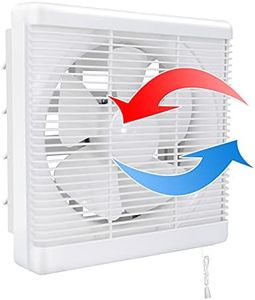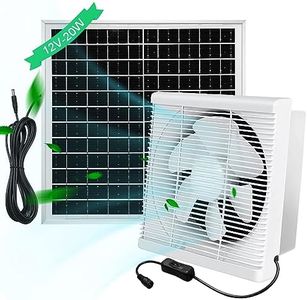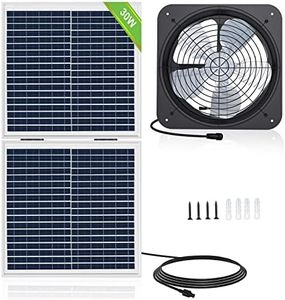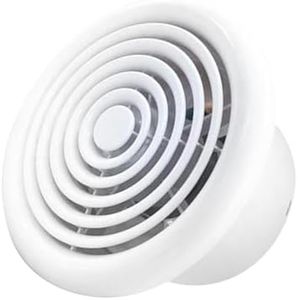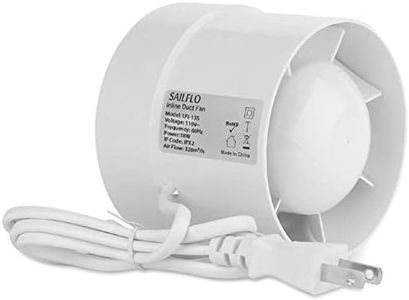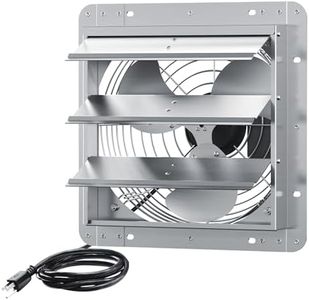We Use CookiesWe use cookies to enhance the security, performance,
functionality and for analytical and promotional activities. By continuing to browse this site you
are agreeing to our privacy policy
10 Best Attic Fans
From leading brands and best sellers available on the web.Buying Guide for the Best Attic Fans
Choosing the right attic fan can make a big difference in maintaining a comfortable temperature in your home, protecting your roof, and improving energy efficiency. Attic fans work by ventilating hot air out of your attic, reducing the strain on your cooling system during warm months. The best choice depends on your attic size, local climate, and personal preferences for installation and operation. Understanding key specifications will help you find a fan that keeps your attic cool and your energy bills in check.Airflow (CFM)CFM, or Cubic Feet per Minute, measures how much air the fan can move in one minute. This is a crucial specification because it tells you how effectively the fan can remove hot air from your attic. Small attics usually need less CFM—often in the 800-1,200 range—while larger ones may require anywhere from 1,500 to over 3,000 CFM. Choosing the right CFM depends on the size of your attic: if your attic is about 1,000 square feet, a mid-range fan might be suitable, while larger spaces need fans with higher CFM. Always match the CFM rating to your attic's size for the most efficient cooling.
Power SourceAttic fans can be powered by electricity or solar energy, and this choice affects both installation and operation. Electric fans require wiring and access to household electricity, offering strong and consistent performance regardless of weather. Solar-powered models are more energy-efficient and environmentally friendly, but their performance varies with sunlight exposure. Think about whether you want a simpler, possibly DIY install (solar), or higher power and reliability (electric). If your area gets a lot of sun and you want a low-maintenance option, solar might be best; for consistent performance even on cloudy days, electric is a sound choice.
Thermostat and Humidistat ControlsBuilt-in thermostats let attic fans turn on and off automatically based on temperature settings, while humidistats control the fan based on moisture levels. These features automate operation, saving energy and preventing unnecessary use. When deciding, consider your local climate: if your summers are hot but not humid, a thermostat alone might be enough; in humid areas or for better mold prevention, a humidistat is useful. These controls reduce hassle and make sure your fan only runs when needed, extending its life and efficiency.
Noise LevelNoise level indicates how loud the fan will be while operating, usually measured in decibels (dB). Quieter fans are ideal if your attic is near living spaces or bedrooms, as some units can be surprisingly noisy. If you are sensitive to noise or your fan will be close to everyday spaces, prioritize models with low dB ratings. For detached garages or less-used attics, a moderate noise level may not be an issue.
Mounting StyleAttic fans can be roof-mounted or gable-mounted. Roof-mounted fans are installed on the roof itself, while gable-mounted fans are fixed to attic walls at the gable. The right style for you depends on your attic’s design and accessibility: gable-mounted fans are usually easier to install if you have an existing gable vent, whereas roof-mounted versions may work better for attics with no side vents. Check your attic's construction and existing venting to determine what will install most easily and work most efficiently.
Fan Size and Blade MaterialFan size refers to the physical diameter or span of the blades, while blade material impacts durability and noise. Larger fans move more air but require more space and stronger supports. Metal blades are generally more durable and handle heat well, but plastic blades can run quieter and resist rust. Choose fan size based on attic area and available installation space. For longevity, metal blades are ideal; for quiet use, plastic may be preferable, especially if noise is a concern.
